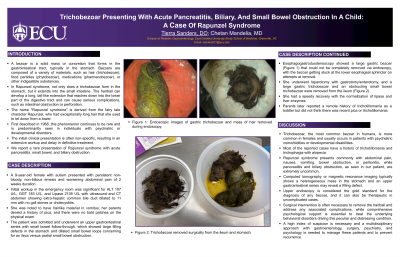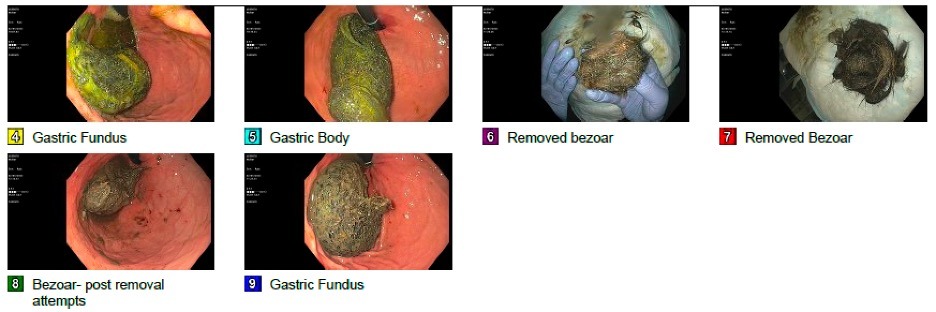Sunday Poster Session
Category: Pediatrics
P1188 - Trichobezoar Presenting with Acute Pancreatitis, Biliary, and Small Bowel Obstruction in a Child: A Case of Rapunzel Syndrome
Sunday, October 22, 2023
3:30 PM - 7:00 PM PT
Location: Exhibit Hall

Has Audio

Tierra Sanders, MS, DO
East Carolina University
Greenville, NC
Presenting Author(s)
Tierra Sanders, MS, DO, Chetan Mandelia, MD
East Carolina University, Greenville, NC
Introduction: Rapunzel Syndrome is characterized by a gastric trichobezoar extending beyond the pylorus. First described in 1968, this phenomenon continues to be rare and is predominantly seen in children, adolescent girls, and young women. We report a rare presentation of Rapunzel syndrome with small bowel obstruction, biliary dilatation, and acute pancreatitis.
Case Description/Methods: A 9-year-old female with autism presented with persistent non-bloody, non-bilious emesis and worsening abdominal pain of 2 weeks duration. Initial workup in the emergency room was significant for ALT 107 U/L, GGT 183 U/L, and Lipase 2105 U/L with ultrasound and CT abdomen showing extra-hepatic common bile duct dilated to 11 mm with no gallstones or cholecystitis. She was noted to have hairlike material in vomitus; her parents denied a history of pica, and there were no bald patches on exam. The patient was admitted and underwent upper GI series with small bowel follow-through, which showed large filling defects in the stomach and dilated small bowel loops concerning for ileus versus partial small bowel obstruction.
Esophagogastroduodenoscopy showed a large gastric bezoar that could not be completely removed via endoscopy, with the bezoar getting stuck at the lower esophageal sphincter on attempts at removal. She underwent laparotomy with gastrotomy/enterotomy, and a large gastric trichobezoar and an obstructing small bowel trichobezoar were removed from the ileum. She had a speedy recovery with the normalization of lipase and liver enzymes. Parents later reported a remote history of trichotillomania as a toddler but did not think there was recent pica or trichotillomania.
Discussion: Trichobezoar, the most common bezoar in humans, usually occurs in patients with psychiatric comorbidities or developmental delay. Most of the reported cases had a history of trichotillomania and trichophagia with alopecia. Rapunzel syndrome presents commonly with abdominal pain, nausea, vomiting, bowel obstruction, or peritonitis, while pancreatitis and biliary obstruction, as seen in our patient, are extremely uncommon. Therefore, a high index of suspicion is necessary, and a multidisciplinary approach with gastroenterology, surgery, psychiatry, and psychology is needed to manage these patients.

Disclosures:
Tierra Sanders, MS, DO, Chetan Mandelia, MD. P1188 - Trichobezoar Presenting with Acute Pancreatitis, Biliary, and Small Bowel Obstruction in a Child: A Case of Rapunzel Syndrome, ACG 2023 Annual Scientific Meeting Abstracts. Vancouver, BC, Canada: American College of Gastroenterology.
East Carolina University, Greenville, NC
Introduction: Rapunzel Syndrome is characterized by a gastric trichobezoar extending beyond the pylorus. First described in 1968, this phenomenon continues to be rare and is predominantly seen in children, adolescent girls, and young women. We report a rare presentation of Rapunzel syndrome with small bowel obstruction, biliary dilatation, and acute pancreatitis.
Case Description/Methods: A 9-year-old female with autism presented with persistent non-bloody, non-bilious emesis and worsening abdominal pain of 2 weeks duration. Initial workup in the emergency room was significant for ALT 107 U/L, GGT 183 U/L, and Lipase 2105 U/L with ultrasound and CT abdomen showing extra-hepatic common bile duct dilated to 11 mm with no gallstones or cholecystitis. She was noted to have hairlike material in vomitus; her parents denied a history of pica, and there were no bald patches on exam. The patient was admitted and underwent upper GI series with small bowel follow-through, which showed large filling defects in the stomach and dilated small bowel loops concerning for ileus versus partial small bowel obstruction.
Esophagogastroduodenoscopy showed a large gastric bezoar that could not be completely removed via endoscopy, with the bezoar getting stuck at the lower esophageal sphincter on attempts at removal. She underwent laparotomy with gastrotomy/enterotomy, and a large gastric trichobezoar and an obstructing small bowel trichobezoar were removed from the ileum. She had a speedy recovery with the normalization of lipase and liver enzymes. Parents later reported a remote history of trichotillomania as a toddler but did not think there was recent pica or trichotillomania.
Discussion: Trichobezoar, the most common bezoar in humans, usually occurs in patients with psychiatric comorbidities or developmental delay. Most of the reported cases had a history of trichotillomania and trichophagia with alopecia. Rapunzel syndrome presents commonly with abdominal pain, nausea, vomiting, bowel obstruction, or peritonitis, while pancreatitis and biliary obstruction, as seen in our patient, are extremely uncommon. Therefore, a high index of suspicion is necessary, and a multidisciplinary approach with gastroenterology, surgery, psychiatry, and psychology is needed to manage these patients.

Figure: A large amount of a trichobezoar in the stomach.
Disclosures:
Tierra Sanders indicated no relevant financial relationships.
Chetan Mandelia indicated no relevant financial relationships.
Tierra Sanders, MS, DO, Chetan Mandelia, MD. P1188 - Trichobezoar Presenting with Acute Pancreatitis, Biliary, and Small Bowel Obstruction in a Child: A Case of Rapunzel Syndrome, ACG 2023 Annual Scientific Meeting Abstracts. Vancouver, BC, Canada: American College of Gastroenterology.
